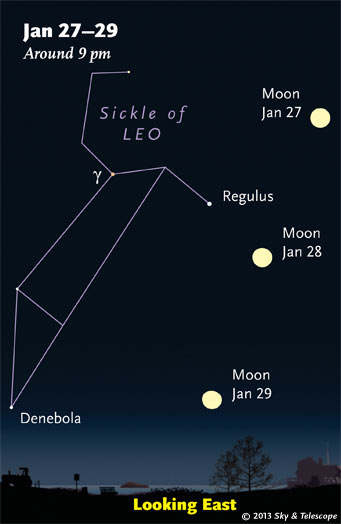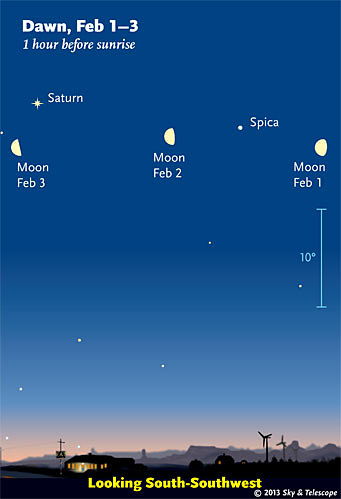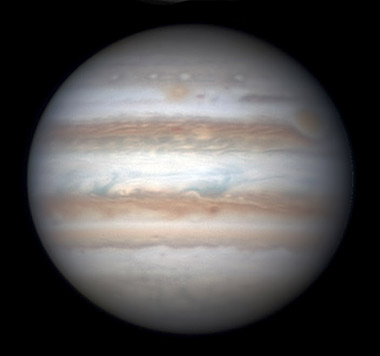Friday, January 25
Saturday, January 26

As it passes full and starts to wane, the Moon moves down through the lair of the Lion.
Sky & Telescope diagram
Sunday, January 27
Monday, January 28
Tuesday, January 29
When to look? Canopus is there at its highest point when Beta Canis Majoris — Mirzim, the star about three finger-widths to the right of Sirius — is at its highest point crossing the meridian. Look straight down from Mirzim then.
Wednesday, January 30

Saturn rises in the middle of the night this week and shines high during dawn. The Moon is positioned here for the middle of North America. The blue 10° scale is about the width of your fist at arm's length.
Sky & Telescope diagram
Thursday, January 31
For all of Jupiter's satellite events and Great Red Spot transit times, good worldwide, get our new JupiterMoons app.
Friday, February 1
Saturday, February 2
Want to become a better amateur astronomer? Learn your way around the constellations. They're the key to locating everything fainter and deeper to hunt with binoculars or a telescope.
For an easy-to-use constellation guide covering the whole evening sky, use the big monthly map in the center of each issue of Sky & Telescope, the essential guide to astronomy. Or download our free Getting Started in Astronomy booklet (which only has bimonthly maps).

The Pocket Sky Atlas plots 30,796 stars to magnitude 7.6 — which may sound like a lot, but that's less than one star in an entire telescopic field of view, on average. By comparison, Sky Atlas 2000.0 plots 81,312 stars to magnitude 8.5, typically one or two stars per telescopic field. Both atlases include many hundreds of deep-sky targets — galaxies, star clusters, and nebulae — to hunt among the stars.
Sky & Telescope
Once you get a telescope, to put it to good use you'll need a detailed, large-scale sky atlas (set of charts). The standards are the little Pocket Sky Atlas, which shows stars to magnitude 7.6; the larger and deeper Sky Atlas 2000.0 (stars to magnitude 8.5); and the even larger Uranometria 2000.0 (stars to magnitude 9.75). And read how to use sky charts with a telescope effectively.
You'll also want a good deep-sky guidebook, such as Sue French's Deep-Sky Wonders collection (which includes its own charts), Sky Atlas 2000.0 Companion by Strong and Sinnott, the bigger Night Sky Observer's Guide by Kepple and Sanner, or the beloved if dated Burnham's Celestial Handbook.
Can a computerized telescope replace charts? Not for beginners, I don't think, and certainly not on mounts and tripods that are less than top-quality mechanically (able to point with better than 0.2° repeatability). As Terence Dickinson and Alan Dyer say in their invaluable Backyard Astronomer's Guide, "A full appreciation of the universe cannot come without developing the skills to find things in the sky and understanding how the sky works. This knowledge comes only by spending time under the stars with star maps in hand."
This Week's Planet Roundup
Mercury is hidden deep in the sunset.
Venus (magnitude –3.9) is just above the southeast horizon 20 minutes before your local sunrise. It's getting lower each morning. Bring binoculars.
Mars (magnitude +1.2) still glimmers very low in the west-southwest in the fading glow of sunset. Don't confuse it with Fomalhaut well to its left.

Jupiter on January 27th. South is up. The orange Oval BA, on the central meridian near top, has now moved far ahead of the Great Red Spot (near the right limb) after passing it in mid-September. Complex bluish festoons jut equatorward from the south edge of the North Equatorial Belt.
Jupiter (magnitude –2.5, in Taurus) is the first "star" to come out high in the southeast after sundown. It dominates the high south after dinnertime, with orange Aldebaran lower left or left of it, and the Pleiades to its upper right or right.
For many weeks, Jupiter has been drawing closer to forming a straight line with Aldebaran and Pleiades. It'll never get there. Jupiter reaches its stationary point on January 30th, when it ceases its retrograde (westward) motion against the stars and starts moving back eastward.
In a telescope, Jupiter has been slowly shrinking as Earth pulls ahead of it in our faster orbit around the Sun. It appears about 44 arcseconds wide. The 5th-magnitude star 0.1° south of it this week is Omega-2 Tauri.
Saturn (magnitude +0.6, in Libra) rises in the east-southeast around 1 a.m. local time. By the beginning of dawn it's fairly high in the south — more or less between Spica, far to its right, and Antares farther to its lower left.
Uranus (magnitude 5.9, in Pisces) is still in view in the southwest right after dark. Finder chart.
Neptune (magnitude 8.0) is lost in the sunset glow in the background of Mars.
All descriptions that relate to your horizon — including the words up, down, right, and left — are written for the world's mid-northern latitudes. Descriptions that also depend on longitude (mainly Moon positions) are for North America. Eastern Standard Time (EST) equals Universal Time (also known as UT, UTC, or GMT) minus 5 hours.
Like This Week's Sky at a Glance? Watch our SkyWeek TV short. It's also playing on PBS!
To be sure to get the current Sky at a Glance, bookmark this URL:
http://SkyandTelescope.com/observing/ataglance?1=1
If pictures fail to load, refresh the page. If they still fail to load, change the 1 at the end of the URL to any other character and try again.
 0
0
Comments
You must be logged in to post a comment.